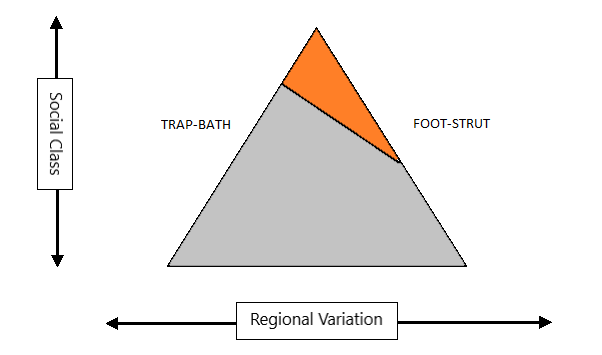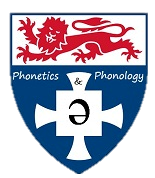Post originally appeared on the PhilSoc Blog
In August 2019, I was supported by a PhilSoc travel bursary to attend the 19th International Congress of Phonetic Sciences, to present a poster. The conference was in Melbourne, hosted by The Australasian Speech Science and Technology Association and had 422 oral presentations and 397 poster presentations. The poster I presented was based on my MA and was also included in the Congress proceedings papers. My title was North-South Dividers in privately educated speakers: a sociolinguistic study of Received Pronunciation using the foot-strut and trap-bath distinctions in the North East and South East of England.
 There is a model of accent variation in England that demonstrates the interactions between regional variation and variation based on social class. The high level of regional variation found in working class speakers seems to reduce going up the socio-economic spectrum, see, with the top of the triangle forming the accent called Received Pronunciation (RP – popularly known as BBC English). However, this model has not been updated for almost 40 years. My research involves recording speakers from different regions whose socio-economic status would place them near the top of this triangle and investigating a variety of accent features that would general display regional variation.
There is a model of accent variation in England that demonstrates the interactions between regional variation and variation based on social class. The high level of regional variation found in working class speakers seems to reduce going up the socio-economic spectrum, see, with the top of the triangle forming the accent called Received Pronunciation (RP – popularly known as BBC English). However, this model has not been updated for almost 40 years. My research involves recording speakers from different regions whose socio-economic status would place them near the top of this triangle and investigating a variety of accent features that would general display regional variation.
The paper I presented discussed what are known as the FOOT-STRUT and TRAP-BATH splits, descriptions of what vowels speaker uses. The FOOT-STRUT split is whether the two words (and those in the same sets) rhyme or not, and the TRAP-BATH split is whether words like bath have the same vowel as TRAP, generally found in the North, or the same vowel as PALM, generally found in the South. In 10 privately educated speakers from the North East and South East I found that they all behaved the same as each other in the FOOT-STRUT split, demonstrating that this feature acts in a  non-regional manner. However, regarding the TRAP-BATH split, I found that the speakers reflected the patterns found in their local region. This is likely due to the social salience of the feature; non-linguists have a strong awareness of how people in different regions pronounce words in the BATH set (e.g. glass, path, mast) and see it as a regional identity marker.
non-regional manner. However, regarding the TRAP-BATH split, I found that the speakers reflected the patterns found in their local region. This is likely due to the social salience of the feature; non-linguists have a strong awareness of how people in different regions pronounce words in the BATH set (e.g. glass, path, mast) and see it as a regional identity marker.
Presenting this poster gave me the opportunity to gain feedback on both my methods and results, invaluable information for data collection for my PhD. I also was able to meet and discuss my findings with leading researchers in the field, whose work has greatly influenced mine. Including the researcher who illustrated the above model, and another who is the only other person currently publishing sociophonetic research on RP.
I would like to thank PhilSoc for awarding me the travel bursary, I used it to supplement the funds my department were able to give in order to make up the required amount. This congress only happens once every four years and I could have missed out on the opportunity to attend without their support.
My poster and proceedings paper can be found on my website.

